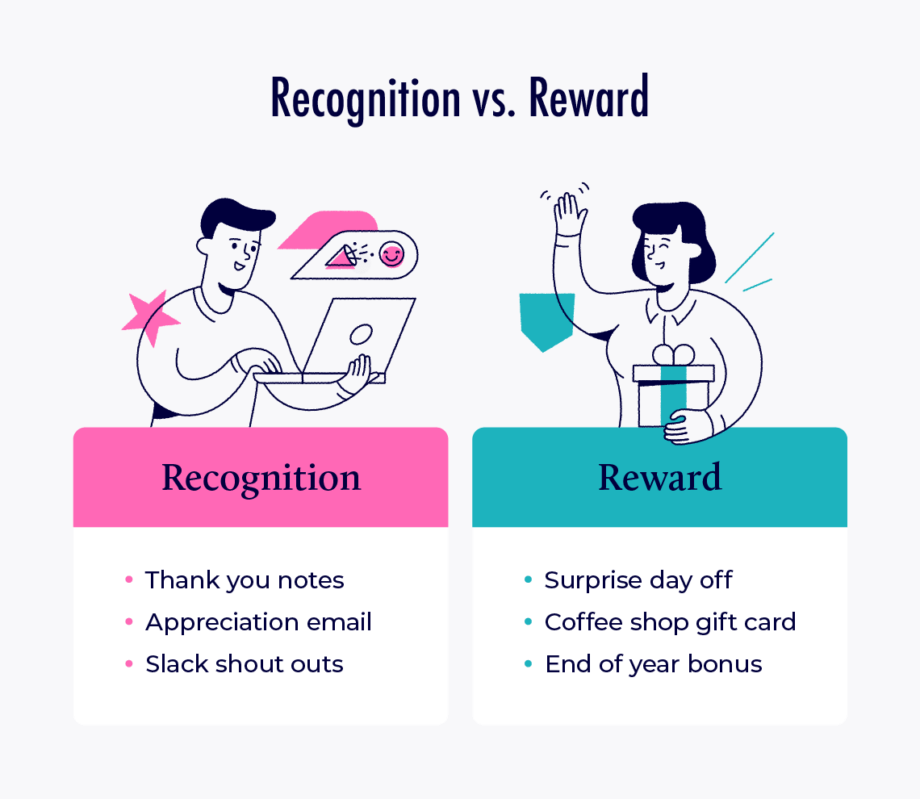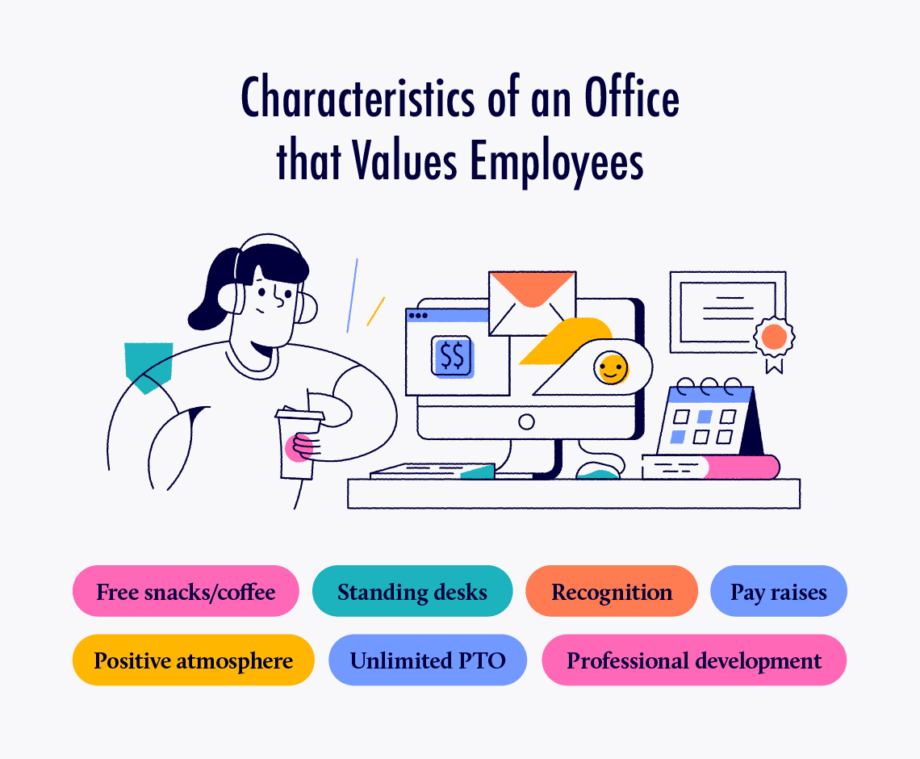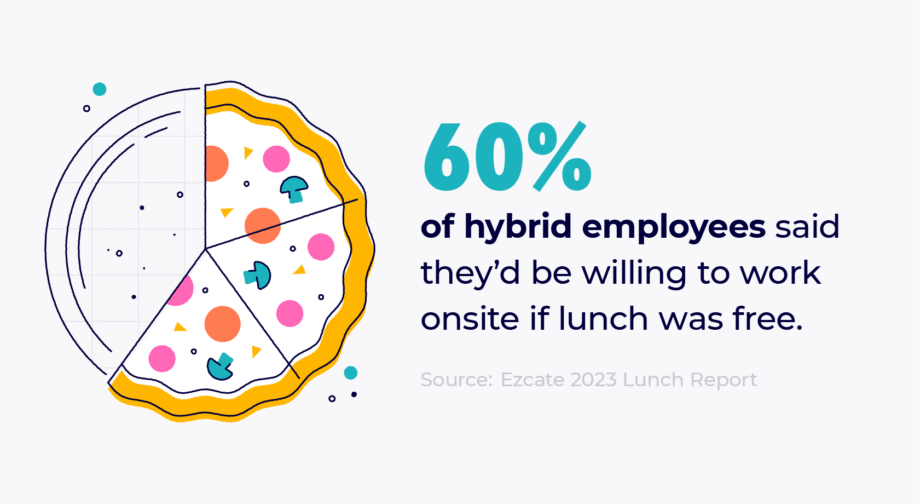Growing up, I was taught to say “please,” “thank you,” and “you’re welcome” for almost every encounter imaginable.
Sure, there were a few times when it felt contrived. But I’ve witnessed the power of these kind and polite words over and over again.
This simple exercise of expressing gratitude builds confidence, fosters fulfilling relationships and is a trait of a great leader.
And as they say, “good manners cost nothing.” The workplace is no different.
Recognizing employees is a simple, effective way to cultivate a welcoming culture that people want to be a part of.
In this article, I will explore 24 meaningful ways to recognize employees in the workplace (beyond traditional rewards and bonuses).
Key Takeaways
- A 2023 study suggests that employees who see their colleagues receive recognition from their leaders have a greater sense of “organizational justice” and will be more likely to be engaged in their work.
- Employee recognition is the cornerstone of a positive work environment and healthy workplace culture.
- Work atmosphere and development opportunities have the strongest correlation to employee satisfaction.
- Regular recognition and reward are key to keeping employees engaged and fulfilled in their roles.
What is Employee Recognition?
Employee recognition is simple — it’s acknowledging an employee’s hard work so that they know you value their contributions and achievements. In 2023, only one-third of employees reported receiving recognition or praise in the past week.
According to a 2022 employee satisfaction study, atmosphere and development in a company have the strongest correlation to employee satisfaction.
What does this mean in human terms? A positive company culture with growth potential is the key to happy employees.
So if this is the top way to improve morale among your employees … why are only one-third of employees receiving this recognition?
In this article, I’m going to share some of my favorite ways to recognize employees so they feel valued and supported at work. Employee recognition programs are so vital because people quit bosses who don’t make them feel motivated and respected.
Recognition vs. Reward
Now, we know what employee recognition is, but how’s it different from a reward?
- Recognition: Creates a positive work culture where employees feel valued
- Reward: Incentivizes positive behaviors to create a successful business outcome
Both recognition and reward are key to making your employees happier, and happy employees are key to long-term growth and success.

Types of Recognition
First, let’s talk through the different types of recognition:
| Top-Down | Recognition from managers or supervisors to their team |
| Peer to Peer | Recognition shared between colleagues |
| Bottom-Up | Recognition from team members to their manager or supervisor |
| Social Recognition | Public recognition shared via social media or internal communication |
| Team-Based Recognition | Recognition given to a team for group efforts and performance |
24 Effective Employee Recognition Programs
If you’re a leader or manager, you’re probably wondering how you can show your employees that you appreciate their hard work. There are endless ways to show your employees that you see what they’re doing, but not all recognition strategies are equal.
Effective employee recognition promotes personal and professional growth and fosters a work appreciation culture. Here are 24 of my favorite employee recognition programs to help your team feel supported and recognized for their hard work.
1. Personalize Employee Recognition
Everyone is different, so everyone appreciates different types of recognition. Some employees love a Slack shout-out after completing a difficult project, while others appreciate a quick thank you note more.
When telling an employee they did something right, I want them to know I’m not just copying and pasting the same message to everyone. Personalization is key.
Rather than guessing, I ask employees how they’d like to be recognized. Not only does this show that you care about supporting their needs, but it also shows that you care about supporting them in ways tailored to their preferences.
2. Push Professional Development Initiatives
Opportunities for professional development are another important aspect of creating a healthy and happy workplace. In 2021, 63% of people who quit their job said that a lack of growth opportunities contributed to their decision to leave. Only 33% of employees feel that their workplace encourages professional development.
Whether it’s a quick midweek training, mentorship opportunities or hosting outside speakers, employees appreciate opportunities to grow their skills — even if they’re not directly useful for your company.
For example, during quarterly reviews, I use the SSK method (Stop / Start / Keep) to better understand how an employee feels about their role and their work.
This gives inspiration for future training, shows that you care about their professional development and ensures that your employees are developing the skills they need most.
3. Surprise Employees with Time Off
Regardless of how much you enjoy your job, team and company, everyone appreciates a surprise day off. Think about it — what was better than a snow day as a kid?
I like surprising everyone with a day off every once in a while, especially in response to work on a tough project or busy week.
According to a 2023 study by Pew Research Center, 62% of workers say that paid time off is extremely important to them at a job, and over half of the workers take less time off out of fear there will be negative consequences for themselves or co-workers.
Show your employees that you want them to take time off to recharge, and by doing so, you’ll improve retention and boost morale.
4. Celebrate All Wins, No Matter How Big or Small
On days where motivation is scarce, I always start with an easier task.
The sense of accomplishment from something minor helps me build momentum to achieve more.
The same goes for employee recognition.
Don’t neglect an employee’s smaller wins — odds are they’re working hard behind the scenes in ways you don’t realize. Letting them know you appreciate the little things they do is a great way to ensure you’re regularly awarding recognition and making your employees feel appreciated.

5. Share Positive Customer Feedback
When a customer or client says something nice about an employee, always pass it along. Knowing that you have a noticeable impact — not just on your co-workers — is a big win.
In fact, I believe this is so important that all of our standard weekly meetings have a section titled “Customer Headlines” where we share positive feedback from customers and recognize the employees who helped them.
Some people worry that too much employee recognition could come across as disingenuous, but I’ve never met a person who has been too encouraged.
I believe that you can’t overdo it when it comes to appreciation. Bringing new voices into the conversation by sharing outside customer feedback is an easy way to show your employees their hard work has a wide reach.
6. Encourage and Facilitate Public Service
Connecting with the community is important, and if you ask anyone, you’ll find that most of them wish they could do more. But it’s hard to find the time in busy schedules to give back.
Encourage your team to help their communities by coordinating community service projects at work or giving them extra time off to volunteer.
When you support community well-being, you also support employee well-being and visibly demonstrate your company’s core values.
7. Match Charity Donations
Just like public service, giving back through charity can help your team feel fulfilled.
Matching charity donations from your employees is another way to support great causes and show them that you care about what matters to them.
At Awesome Motive, we’ve prioritized giving back with donations to educational initiatives, conservation projects and organizations like No Kid Hungry to share our success and make the world a better place.
8. Prioritize Health and Wellness
Promoting healthy habits improves physical and mental health for the entire company. There are many different ways to support your employees’ health:
- Encourage daily walks or stretch breaks
- Host company wide meditation meetings
- Offer days off to recharge mentally and emotionally
- Make standing desks an option
- Allow employees to work from home
As a company leader, I try my best to lead by example here. When employees see a manager being open about taking time to work on themself, they know that they can too.
9. Encourage Peer-to-Peer Recognition
A rising tide lifts all boats.
That’s to say, a culture that makes its employees feel seen benefits everyone at a company. It feels just as good to send recognition as to receive it.
I work hard to create a culture of appreciation within my teams. It’s important to lead by example and actively share what you’re doing with other leaders at your workplace to cultivate positivity.
This way, your influence spreads beyond your direct reports to the entire company.
10. Offer No Meeting Days
Whether in person or remote, no one likes getting stuck in meetings all day.
Establish a company-wide day where there will be no internal or external meetings to allow people to recharge their social batteries.
Setting a meeting-free workday shows that you trust your employees to manage their time and responsibilities while prioritizing their productivity and well-being.
I call these days “deep work” days because they allow for uninterrupted time to focus on the priorities that matter most.
It’s amazing how productive your employees can be when they know that you’ve protected their time to do their best and most meaningful work.
11. Gamify Required Training
Training can be a snooze, so you should try to make it fun!
Gamify required training and meetings to switch it up and have some fun in the office. You can host a version of “Jeopardy” and test your employees’ knowledge on industry updates or raffle off a few coffee shop gift cards to build morale.
12. Send Your Team Home Early
Let’s face it, not many team members are going to be mad about leaving work early. In fact, I’m sure most would be delighted.
Whether they use this opportunity to run some errands or hang out with their pets at home, a surprise half-day is a huge morale boost, especially during a busy season for your company.
13. Encourage Employee-Led Learning and Training
Everyone brings something different to the table.
If you’re not allowing your employees to develop or share those skills and ideas, you’re missing out!
I was lucky to discover and develop my passion during college — but I’m always growing, and so are your employees.
Giving team members the space to develop their ideas shows that you trust them and care about their future successes — a win for everyone involved.
14. Say Thanks Often
A little gratitude goes a long way.
Think about it. You might not notice every time someone thanks you for holding a door open, but you surely notice when they don’t.
Saying thank you is more than just good manners — it’s free, and shows your team that you notice and care about all the work they do.

15. Be Authentic
Authenticity is vital to effective communication.
A thoughtful note talking through specific wins shows you’re truly paying attention to your team’s successes.
When recognizing someone’s achievements, be genuine about why you think they deserved it. I’ll often add key details about why an employee deserves this recognition so they know I’m paying attention to their successes.
16. Gift Company Merchandise
Gifting employees with company brand shirts, mugs or even pens can go a long way toward building a strong culture that values its people. It’s a way of thanking your team members and making them feel like they’re a part of your company’s brand.
If possible, set aside a budget that your human resources team can use for employee engagement. If funds are limited, hosting raffles that offer company merchandise can also be an effective incentive.
17. Provide Proper Equipment
In my experience, this practical employee recognition program feeds two birds with one hand. First, you’ll boost your team’s morale by showing them that you care about their workplace needs.
Secondly, you’ll supply your employees with the equipment they need to excel in their roles. New employees might benefit greatly from a company computer until they can purchase a better machine.
18. Supply Complimentary Meals
A study by Cornell University found that firefighters who ate meals together also performed drastically better in the field. Providing complimentary meals to your team members can help them feel more like a cohesive unit over time.
Free meals can also incentivize hybrid employees to return to the office rather than work from home. This program can also help your team members save money that they otherwise would’ve spent eating out.

19. Organize Company Outings
Company outings are the sort of employee recognition program that leaves plenty of room for creativity. A picnic at a local park is a tried and true option that can help leaders and team members connect in a low-stakes environment.
On the flip side, you can sign your team up for something more kinetic; a company baseball game, a charity walk or even a full blown team retreat will get their hearts pumping and put smiles on their faces.
You can even give DIY awards to employees who knock it out of the park (figuratively and literally) at these events.
20. Highlight Employees on Social Media
Showing empathy is one of the factors that separates a boss vs a leader. Social media highlights aren’t just meant to showcase an impressive project that one of your team members completed. They are also meant to give your employees a sense of pride and connection to your company.
I feel it’s best to check with your team members to ensure that you know who is and who isn’t okay with having a heightened online presence. And when you make the post, center your employee’s unique story and impact on your company.
21. Celebrate Birthdays and Anniversaries
Celebrating employee anniversaries and birthdays can work well in-office or even remotely. At the start of each month, you can give sincere regards to every team member who’ll complete another orbit around the Sun.
With anniversaries, you get to celebrate an employee’s longstanding commitment to your organization. This kind of recognition can inspire other employees to stay with your company, but the main focus should be on the team member who’s been with you for months, years or even decades.
22. Spotlight Employee Skills
I think it’s important to remember that every member of your organization is a unique person with countless life experiences.
This employee recognition program lets you celebrate your team members for their distinct skills, even if they aren’t related to their roles.
If one of your HR representatives has a background in public speaking, highlight that skill — and see if that person would be comfortable leading a meeting or training on their subject of expertise.
Spotlighting your team’s various skills can potentially foster effective collaboration in ways you might’ve never expected.
23. Allow for Volunteer Days
Tying into my last point, each member of your organization also has causes that they’re incredibly passionate about. Making space for volunteer days creates a wealth of opportunities for you and your employees.
They’ll have the opportunity to serve their communities (and possibly spread the word about your organization’s initiative to others).
24. Arrange Mentor Programs
Mentorship is an integral step when it comes to leading yourself throughout your career and in your personal life.
In the same way you need parents and professors to help you find your bearings, you also need mentors to guide you in your current and future roles.
The American Society for Training and Development found that organizations with formal mentoring programs experienced higher employee retention and engagement rates.

How to Build a Genuine Recognition Program
People can spot whether you’re being genuine a mile away. So how can you show them you’re being authentic? Try these tips below.
Start with Your Company Culture
When you’re building any new program for your company, start with company culture. If you’re not sure where to start, ask your team about their values and start from there.
Odds are, when people work well together, there are common values that contribute to this synergy. This is what you can build off of.
For example, at Awesome Motive, our core values are:
- We put people first, always.
- We do the right thing every time.
- We fight for our customer’s success.
- We commit to excellence by paying attention to details.
- We labor for simplicity.
When you define your existing company culture and set goals to work toward, you help create a recognition program that aligns with your company’s mission statement, vision and values.
Get Personal
At the end of the day, you should tailor recognition to your team. You know them better than anyone at your workplace, so use your best judgment.
Build a gratitude or recognition program around your team and their needs. If I notice a team member struggling or working hard on a particular task, I’ll let them know that I see their work and appreciate them pushing through to deliver great work.
Be Consistent
Consistency is key when it comes to building a successful recognition program.
Employee recognition should be a touchstone of company culture — not an afterthought.
If you need to, don’t be afraid to set calendar reminders to send appreciative messages to your team to help you get into the habit. Shifting to a gratitude-based setting might take some getting used to, but the positivity pays back tenfold.
Ask for Feedback
Regardless of how successful you think your employee recognition practices are — consult your team for how they feel.
I like to send out anonymous feedback forms regularly to touch base with my team and ensure they feel heard. Ask some of your employees where they feel most or least supported, and leave space for them to share their own ideas
Unlock the Power of Praise
Are you looking to join a company where your achievements, big and small, are celebrated? At Awesome Motive, our employees are at the heart of everything we do, and we show our appreciation through unlimited PTO, performance bonuses, flexible hours and more.
When you’re ready, explore our open positions to join a team that values employee recognition and makes the world a better place.
To gratitude in all areas of life,
Thomas







Leave a Reply